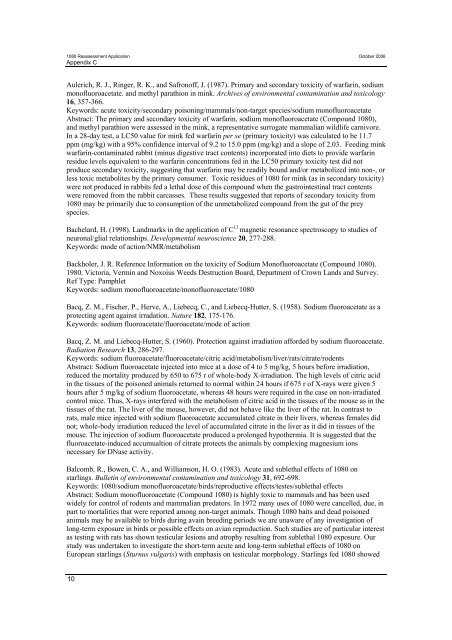Source: Landcare Research (1964). Control of poisons. Royal ...
Source: Landcare Research (1964). Control of poisons. Royal ...
Source: Landcare Research (1964). Control of poisons. Royal ...
Create successful ePaper yourself
Turn your PDF publications into a flip-book with our unique Google optimized e-Paper software.
1080 Reassessment Application October 2006<br />
Appendix C<br />
Aulerich, R. J., Ringer, R. K., and Safron<strong>of</strong>f, J. (1987). Primary and secondary toxicity <strong>of</strong> warfarin, sodium<br />
mon<strong>of</strong>luoroacetate. and methyl parathion in mink. Archives <strong>of</strong> environmental contamination and toxicology<br />
16, 357-366.<br />
Keywords: acute toxicity/secondary poisoning/mammals/non-target species/sodium mon<strong>of</strong>luoroacetate<br />
Abstract: The primary and secondary toxicity <strong>of</strong> warfarin, sodium mon<strong>of</strong>luoroacetate (Compound 1080),<br />
and methyl parathion were assessed in the mink, a representative surrogate mammalian wildlife carnivore.<br />
In a 28-day test, a LC50 value for mink fed warfarin per se (primary toxicity) was calculated to be 11.7<br />
ppm (mg/kg) with a 95% confidence interval <strong>of</strong> 9.2 to 15.0 ppm (mg/kg) and a slope <strong>of</strong> 2.03. Feeding mink<br />
warfarin-contaminated rabbit (minus digestive tract contents) incorporated into diets to provide warfarin<br />
residue levels equivalent to the warfarin concentrations fed in the LC50 primary toxicity test did not<br />
produce secondary toxicity, suggesting that warfarin may be readily bound and/or metabolized into non-, or<br />
less toxic metabolites by the primary consumer. Toxic residues <strong>of</strong> 1080 for mink (as in secondary toxicity)<br />
were not produced in rabbits fed a lethal dose <strong>of</strong> this compound when the gastrointestinal tract contents<br />
were removed from the rabbit carcasses. These results suggested that reports <strong>of</strong> secondary toxicity from<br />
1080 may be primarily due to consumption <strong>of</strong> the unmetabolized compound from the gut <strong>of</strong> the prey<br />
species.<br />
Bachelard, H. (1998). Landmarks in the application <strong>of</strong> C 13 magnetic resonance spectroscopy to studies <strong>of</strong><br />
neuronal/glial relationships. Developmental neuroscience 20, 277-288.<br />
Keywords: mode <strong>of</strong> action/NMR/metabolism<br />
Backholer, J. R. Reference Information on the toxicity <strong>of</strong> Sodium Mon<strong>of</strong>luoroacetate (Compound 1080).<br />
1980. Victoria, Vermin and Noxoius Weeds Destruction Board, Department <strong>of</strong> Crown Lands and Survey.<br />
Ref Type: Pamphlet<br />
Keywords: sodium mon<strong>of</strong>luoroacetate/mon<strong>of</strong>luoroacetate/1080<br />
Bacq, Z. M., Fischer, P., Herve, A., Liebecq, C., and Liebecq-Hutter, S. (1958). Sodium fluoroacetate as a<br />
protecting agent against irradation. Nature 182, 175-176.<br />
Keywords: sodium fluoroacetate/fluoroacetate/mode <strong>of</strong> action<br />
Bacq, Z. M. and Liebecq-Hutter, S. (1960). Protection against irradiation afforded by sodium fluoroacetate.<br />
Radiation <strong>Research</strong> 13, 286-297.<br />
Keywords: sodium fluoroacetate/fluoroacetate/citric acid/metabolism/liver/rats/citrate/rodents<br />
Abstract: Sodium fluoroacetate injected into mice at a dose <strong>of</strong> 4 to 5 mg/kg, 5 hours before irradiation,<br />
reduced the mortality produced by 650 to 675 r <strong>of</strong> whole-body X-irradiation. The high levels <strong>of</strong> citric acid<br />
in the tissues <strong>of</strong> the poisoned animals returned to normal within 24 hours if 675 r <strong>of</strong> X-rays were given 5<br />
hours after 5 mg/kg <strong>of</strong> sodium fluoroacetate, whereas 48 hours were required in the case on non-irradiated<br />
control mice. Thus, X-rays interfered with the metabolism <strong>of</strong> citric acid in the tissues <strong>of</strong> the mouse as in the<br />
tissues <strong>of</strong> the rat. The liver <strong>of</strong> the mouse, however, did not behave like the liver <strong>of</strong> the rat. In contrast to<br />
rats, male mice injected with sodium fluoroacetate accumulated citrate in their livers, whereas females did<br />
not; whole-body irradiation reduced the level <strong>of</strong> accumulated citrate in the liver as it did in tissues <strong>of</strong> the<br />
mouse. The injection <strong>of</strong> sodium fluoroacetate produced a prolonged hypothermia. It is suggested that the<br />
fluoroacetate-induced accumualtion <strong>of</strong> citrate protects the animals by complexing magnesium ions<br />
necessary for DNase activity.<br />
Balcomb, R., Bowen, C. A., and Williamson, H. O. (1983). Acute and sublethal effects <strong>of</strong> 1080 on<br />
starlings. Bulletin <strong>of</strong> environmental contamination and toxicology 31, 692-698.<br />
Keywords: 1080/sodium mon<strong>of</strong>luoroacetate/birds/reproductive effects/testes/sublethal effects<br />
Abstract: Sodium mon<strong>of</strong>luoroacetate (Compound 1080) is highly toxic to mammals and has been used<br />
widely for control <strong>of</strong> rodents and mammalian predators. In 1972 many uses <strong>of</strong> 1080 were cancelled, due, in<br />
part to mortalities that were reported among non-target animals. Though 1080 baits and dead poisoned<br />
animals may be available to birds during avain breeding periods we are unaware <strong>of</strong> any investigation <strong>of</strong><br />
long-term exposure in birds or possible effects on avian reproduction. Such studies are <strong>of</strong> particular interest<br />
as testing with rats has shown testicular lesions and atrophy resulting from sublethal 1080 exposure. Our<br />
study was undertaken to investigate the short-term acute and long-term sublethal effects <strong>of</strong> 1080 on<br />
European starlings (Sturnus vulgaris) with emphasis on testicular morphology. Starlings fed 1080 showed<br />
10








![Application for test certificate [pdf, 131kb]](https://img.yumpu.com/50666502/1/184x260/application-for-test-certificate-pdf-131kb.jpg?quality=85)








